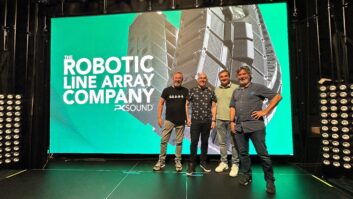
Paddy Baker attends a demonstration of the latest member of Meyer Sound’s LEO speaker family – and finds that high SPL and subtlety can go hand in hand.
LINA is the latest and slimmest line array from Meyer Sound. Launched this summer, it had its first major public outing at InfoComm. Last month, the company’s UK operation held a demo of LINA, along with fellow members of the LEO loudspeaker family, on the back of some training sessions.
The venue is Fly By Nite Studios in Redditch, on the outskirts of Birmingham – a fairly anonymous building on an industrial estate, which contains a purpose-built rehearsal studio roughly 40m by 40m, and 20m high. The equipment is set up close to one of the corners.
The presentation begins with some history on the origins of Meyer Sound and the development of its product lines – led by Andy Davies from Meyer Sound UK technical support. The company sets great store by the linearity of the responses of its speakers. They are designed to colour the sound as little as possible – even the subs – and they should sound the same at all levels.
The LEO family and their associated subs have been optimised for what the company calls ‘native mode’: if array cabinets and subs are deployed in a specific ratio, they have been designed to give an uncoloured sound without the addition of EQ. Although not all of today’s speakers are in native mode, we’re told that very little EQ has been used.
Resolution and symmetry
LYON and LEOPARD arrays are first up, then it’s LINA, which is the successor to the MINA cabinet, first released in 2010. MINA was the first Meyer Sound array cabinet to position the LF drivers behind the horn. “This added fantastic resolution and, particularly, symmetry to the output characteristics, which we really liked,” says Davies. This layout fed into the design of subsequent Meyer Sound array cabinets, starting with LEO and eventually reaching LINA.
Like MINA, LINA consists of two 6.5in long-excursion LF drivers behind a horn with a 3in HF compression driver. However, most of the other aspects have been updated. In a video, Pablo Espinosa, vice president of R&D at Meyer Sound, explains: “Internally, everything is different: the amplifier, the power supply, the HF driver, the LF drivers, are all different” – as well as how the cabinet has been optimised for low distortion and improved low-frequency response.
The upshot is the new cabinet produces 3dB more SPL than MINA; and these components are also lighter, so a LINA cabinet weighs just 19.6kg.
The LINA cabinets are demoed both with and without the LFC-750 companion bass cabinets. These are put through their paces in flown and groundstacked configurations.
A hang of seven LINA cabinets is topped with three LFC-750s – the middle one of which is reversed to provide a cardioid pattern. The groundstacked system comprises three LINAs with two LFC-750s.
We first hear the flown LINAs on their own – on an intimate acoustic track by Alison Krauss and Union Station. Vocal intelligibility is excellent here, even on softly sung lines. Coverage is good and even both from side to side and from front to back.
The flown LFC-750s are added for a track by Seal. I don’t hear as much additional bass presence as I was expecting, but I think that is down to the track itself – the drums, when they come in, are quite light in the mix.
The two LFC-750s on the ground are added for a Donald Fagen track. “Sounds pretty good!” I write in my notebook.
The next track, one by Toto, is played on the groundstacked LINA and LFC-750 system, and it fills the room with sound just as effectively as the flown system – although presumably, with half the number of cabinets, it’s had to be driven a little harder to achieve this.
Full system
The final two songs are played through the full demo system: LYON, LEOPARD and LINA arrays with LFC-1100 and LFC-750 subs. An AC-DC track is as loud – but not painfully so – and heavy as one could hope for.
More unexpected, though, was the sensation from a London Grammar track: rather than a kick-drum punch to the chest, this song makes my body physically tingle all over. I’m not sure I remember a feeling quite like this at any other speaker demo.
Just as I’m wondering how to sum up what I’ve heard, a testimonial quote flashes up on the presentation screen from the FOH and production manager for the band Bassnectar: “LEO allows me to make extremely fine changes at high volumes… I can actually hear the subtleties.” That’s absolutely it. This afternoon I’ve heard rock, folk, electro, indie, chamber music and more – all rendered with extreme clarity. The fine details – the twang of a bass string, the clink of a tambourine – are all there to hear; not to distract you from the song, but to enhance your enjoyment of the music.







